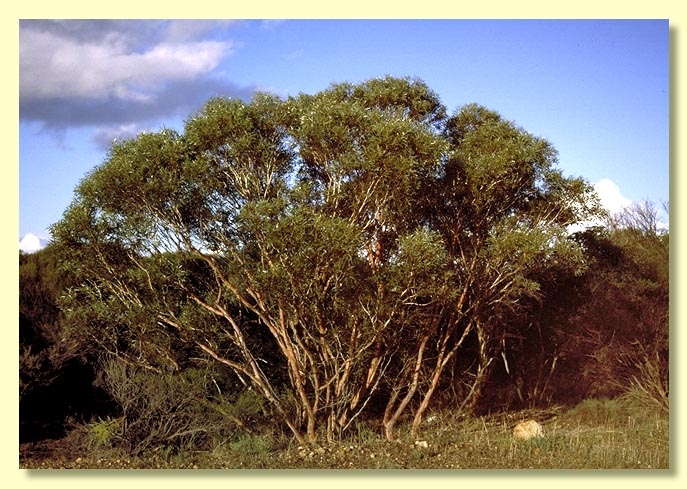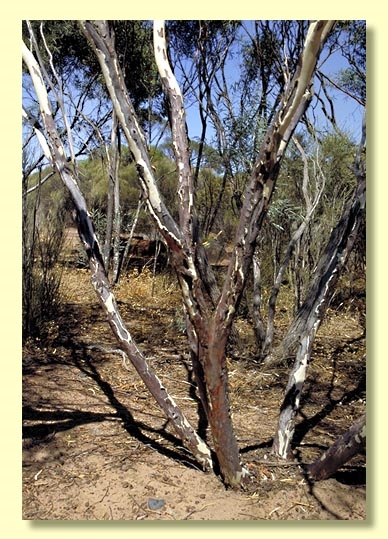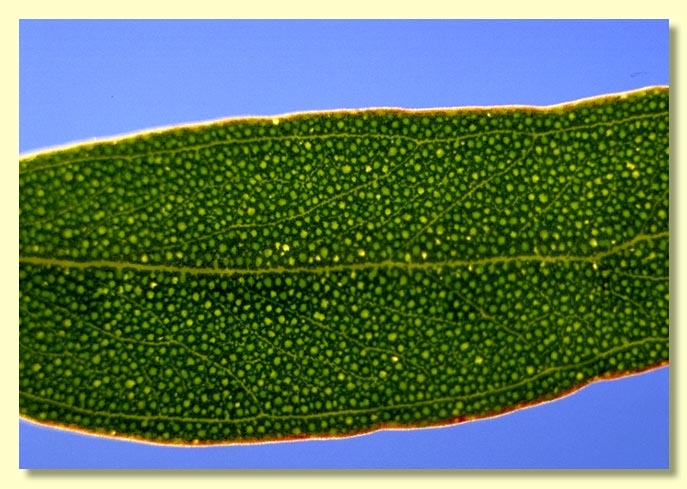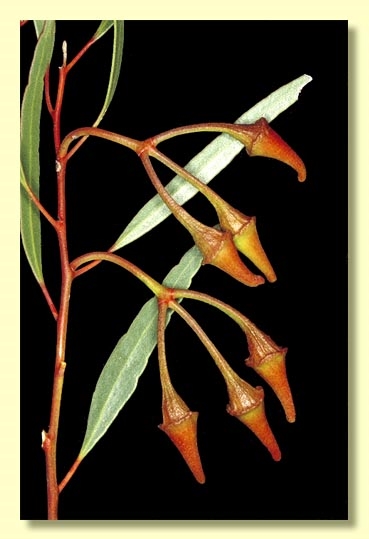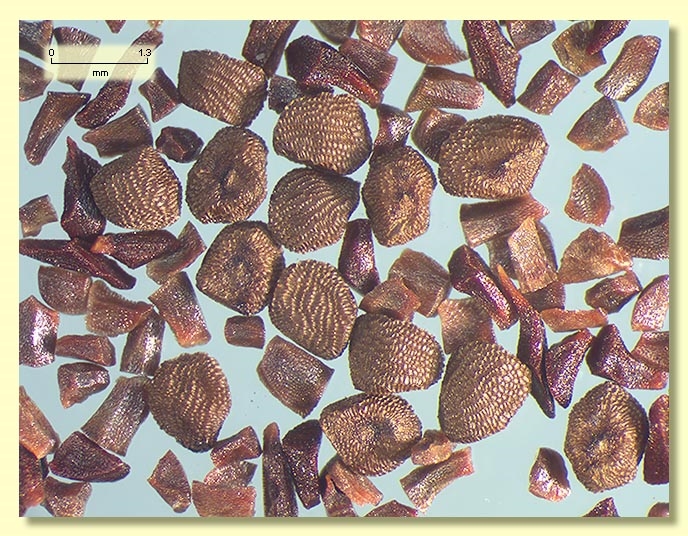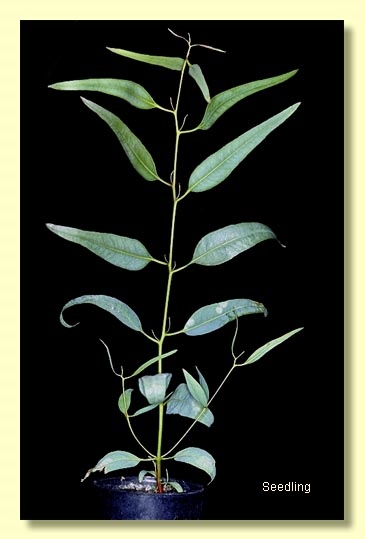Euclid - Online edition
Eucalyptus armillata
Eucalyptus | Symphyomyrtus | Bisectae | Glandulosae | Elongatae
Eucalyptus armillata D.Nicolle & M.E.French, Nuytsia 22(6): 456 (2012).
T: Western Australia: approach to Kalguddering Rock from west [south of Wongan Hills], 2 Jan. 1980, M.I.H. Brooker 6759; holo: PERTH; iso: CANB, DNA.
E. conoidea var. marginata Benth., Fl. Austral. 3: 227 (1867); Eucalyptus erythronema var. marginata (Benth.) Domin, Repert. Spec. Nov. Regni Veg. 12: 389 (1913); T. Swan R. Colony, W.A., J.Drummond 3: 56; holo: K.
Bark smooth throughout, dark satiny pink-brown to pink-grey or dark red shedding in thin sheets to reveal powdery creamy white.
Branchlets with oil glands in the pith, non-glaucous.
Juvenile growth (coppice or field seedlings to 50 cm): not seen.
Adult leaves alternate, petioles 0.3–1.5 cm long; blade lanceolate to narrowly so, 3–8.5(11) cm long, 0.5–1.5 cm wide, base tapering to petiole, margin entire, apex pointed, concolorous, olive-green to green, glossy, side-veins acute, reticulation sparse or obscure, broken, intramarginal vein present, oil glands very numerous, more or less round.
Inflorescence axillary unbranched, pendulous, peduncles terete, slender, 1.3–4.5 cm long, buds 3(7) per umbel, long-pedicellate (pedicels 1.3–2.7(4) cm long). Mature buds broadly fusiform (2–3 cm long, 0.9–1.5 cm wide) with a prominent encircling flange on the hypanthium immediately below the join with the operculum, hypanthium usually irregularly ribbed, scar present (outer operculum shed very early), inner operculum conical or beaked, a few outer stamens fully erect but most stamens variably to fully inflexed, anthers oblong, versatile, dorsifixed, dehiscing by longitudinal slits, style long and straight, stigma blunt to tapered, locules 4 or 5, the placentae each with 6 vertical rows of ovules; inner operculum sheds at flowering leaving a conspicuous broad vertical scar encircling the developing fruit. Flowers reddish (or rarely creamy yellow).
Fruit down-turned, pedicellate (pedicels 1.3–2.5(4) cm long), obconical with an encircling flange conspicuous below the broad vertical inner operculum abscission scar, 0.8–1.5 cm long, 1–1.8 cm wide, ribbed or virtually smooth, disc usually level to gently descending, valves 4 or 5, rim level to scarcely exserted.
Seeds brown, 0.5–2 mm long, ovoid to flattened-ovoid, dorsal surface clearly and shallowly reticulate, hilum ventral.
Cultivated seedlings (measured at node 10): cotyledons Y-shaped (bisected); stems rounded in cross-section, warty; leaves always petiolate, opposite for 4 to 6 nodes then alternate, lanceolate, 6.5–11.5 cm long, 1.2–2.5 cm wide, green to grey-green, dull at first.
Flowering has been recorded in January, February, October, November and December.
Eucalyptus armillata is an erect mallee species endemic to Western Australia, found in the central-northern wheatbelt from Calingiri north to Coorow extending east into slightly drier country as far as Wubin and Beacon. The bark is very attractive, varying seasonally from powdery white to dark reddish and pink-brown. The adult leaves are glossy, olive-green to green with all but the mid-rib, side-veins and intramarginal vein obscured by oil glands. Buds and fruit are pendulous in the crown.
In the classification of Brooker (2000) E. armillata belongs in Eucalyptus subgenus Symphyomyrtus section Bisectae subsection Glandulosae because the buds have an operculum scar, cotyledons are bisected and branchlets have oil glands in the pith. Within this large subsection (ca 80 species) E. Armillata is closely related to a group of mallees and mallets (series Elongatae ) recognised by the glossy green leaves with many oil glands obscuring the reticulation but not the main side-veins, buds with very long conspicuous pedicels, short broad opercula, inflexed stamens and ovules in 6 vertical rows. There are five species in series Elongatae—E. cylindriflora, E. cerasiformis, E. dielsii, E. armillata and E. erythronema (with two subspecies).
E. armillata has recently been split from E. erythronema and it is useful to compare them here. All three taxa have highly distinctive pendulous buds and fruit:
E. erythronema subsp. erythronema
Buds at least weakly waxy, flowers red and branchlets conspicuously white waxy (glaucous). The buds and fruits are not flanged, and ribbing, if present at all, is weak. It occurs in the central wheatbelt from Wyalkatchem south-east to Hyden and extending east into the drier areas towards Bullfinch. Occurs on a variety of sandy to loamy well drained soils on slightly rising ground (see Nicolle & French, 2012). (Formerly E. erythronema var. erythronema in part).
E. erythronema subsp. inornata
Buds not waxy, flowers creamy yellow; branchlets usually not waxy (non-glaucous). The buds and fruits are not flanged, and ribbing, if present at all, is weak. It occurs in the central and southern wheatbelt from Wyalkatchem south then east in an arc to near Kulin and Pingaring. Occurs on slightly rising ground on a variety of well-drained soil types (see Nicolle & French, 2012). (Formerly E. erythronema var. erythronema in part).
E. armillata
The buds are strongly flanged around the middle and this flange is obvious in the fruiting stage. Buds and fruit are usually weakly and irregularly ribbed also. Flowers predominantly red; buds and branchlets always non-glaucous. It occurs only in the central-northern wheatbelt in an area bounded by Calingiri, Coorow, Canna, Wubin and Beacon, on level sites with gravelly soil. (Formerly known as E. erythronema var. marginata).

